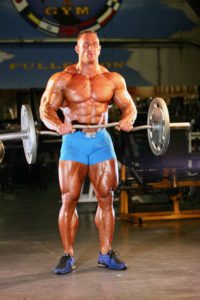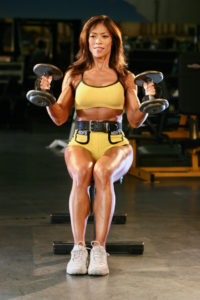
How body position influences your training progress
By Strength Sensei CP
I am often asked which is better, standing exercises or seated? The answer is, “It depends!”
Some exercises are best performed seated. For example, I usually don’t recommend that bodybuilders or other athletes perform barbell rows. Yes, I realize Dorian Yates was a fan, but I believe that too much neural drive is expended contracting the muscles involved in maintaining proper posture during this movement. That is, the trainee expends so much effort contracting the erector spinae, glutes, and hamstrings that they can’t overload the lats adequately. A much better alternative would be a one-arm dumbbell row on a bench.
Along the same thought process, I often favor seated arm exercises over standing for developing hypertrophy. Using a medical testing device that measures the electrical activity of the muscles (electromyography, or EMG), it’s been found that Scott curls produce more involvement of the elbow flexors than standing barbell curls. Just the act of standing diverts some of the neutral drive away from the arms. Further, as you perform a standing barbell curl, the erector spinae and glutes muscle increase their contraction to stabilize your body. In this sense, a barbell curl can be considered a “core” exercise!
Another plus with seated exercises is there is less likelihood of using poor technique. Have doubts? Spend a few minutes watching the typical gym member performing barbell curls. Seriously, I have heard of bodybuilders overcoming training plateaus in arm development when they focused on seated exercises because they had to use better form on their curling movements. Of course, there are those who can still find ways to cheat even from a seated position, but at least sitting down forces them to be more creative about it!
 Seated curls offer many advantages over standing curls for increasing arm development. (Photos by Miloš Šarčev)
Seated curls offer many advantages over standing curls for increasing arm development. (Photos by Miloš Šarčev)
Having discussed the pros of seated exercise, let’s talk about the pros of standing exercises.
Yes, seated exercises reduce the work of your stabilizing muscles, but athletes need strength in these muscles to perform. Also, consider that standing exercises such as the Olympic lifts teach athletes to apply force explosively in the optimal sequence.
For bodybuilders, there are many standing exercises that can’t be beat for the mass-producing benefits. Squats for quads, deadlifts for back development, and barbell standing presses for the shoulders — all proven mass builders!
Standing or seated exercises? Regardless of your training goals, both should have a place in your training toolbox!
